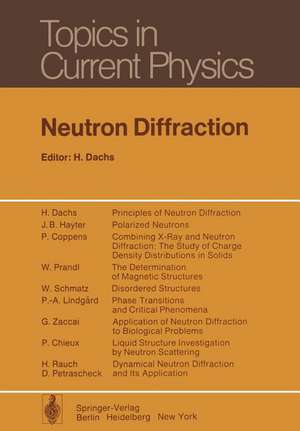Neutron Diffraction: Topics in Current Physics, cartea 6
Editat de H. Dachsen Limba Engleză Paperback – 15 dec 2011
Din seria Topics in Current Physics
-
 Preț: 393.13 lei
Preț: 393.13 lei -
 Preț: 401.61 lei
Preț: 401.61 lei - 15%
 Preț: 644.63 lei
Preț: 644.63 lei -
 Preț: 389.31 lei
Preț: 389.31 lei -
 Preț: 391.99 lei
Preț: 391.99 lei - 15%
 Preț: 642.18 lei
Preț: 642.18 lei -
 Preț: 388.90 lei
Preț: 388.90 lei -
 Preț: 382.95 lei
Preț: 382.95 lei -
 Preț: 398.53 lei
Preț: 398.53 lei -
 Preț: 402.98 lei
Preț: 402.98 lei -
 Preț: 387.96 lei
Preț: 387.96 lei -
 Preț: 388.72 lei
Preț: 388.72 lei -
 Preț: 393.13 lei
Preț: 393.13 lei -
 Preț: 397.38 lei
Preț: 397.38 lei - 15%
 Preț: 642.83 lei
Preț: 642.83 lei -
 Preț: 384.86 lei
Preț: 384.86 lei -
 Preț: 383.33 lei
Preț: 383.33 lei -
 Preț: 385.25 lei
Preț: 385.25 lei -
 Preț: 382.36 lei
Preț: 382.36 lei -
 Preț: 382.36 lei
Preț: 382.36 lei -
 Preț: 382.18 lei
Preț: 382.18 lei -
 Preț: 384.86 lei
Preț: 384.86 lei -
 Preț: 397.59 lei
Preț: 397.59 lei - 15%
 Preț: 639.08 lei
Preț: 639.08 lei -
 Preț: 396.62 lei
Preț: 396.62 lei -
 Preț: 391.40 lei
Preț: 391.40 lei -
 Preț: 382.75 lei
Preț: 382.75 lei -
 Preț: 392.75 lei
Preț: 392.75 lei -
 Preț: 392.60 lei
Preț: 392.60 lei - 15%
 Preț: 643.16 lei
Preț: 643.16 lei -
 Preț: 392.97 lei
Preț: 392.97 lei -
 Preț: 407.01 lei
Preț: 407.01 lei - 15%
 Preț: 638.43 lei
Preț: 638.43 lei -
 Preț: 394.87 lei
Preț: 394.87 lei -
 Preț: 395.09 lei
Preț: 395.09 lei - 15%
 Preț: 641.38 lei
Preț: 641.38 lei -
 Preț: 402.38 lei
Preț: 402.38 lei -
 Preț: 390.63 lei
Preț: 390.63 lei -
 Preț: 387.38 lei
Preț: 387.38 lei -
 Preț: 398.35 lei
Preț: 398.35 lei -
 Preț: 393.35 lei
Preț: 393.35 lei -
 Preț: 384.09 lei
Preț: 384.09 lei - 15%
 Preț: 641.03 lei
Preț: 641.03 lei -
 Preț: 397.01 lei
Preț: 397.01 lei -
 Preț: 395.47 lei
Preț: 395.47 lei -
 Preț: 399.67 lei
Preț: 399.67 lei - 15%
 Preț: 642.83 lei
Preț: 642.83 lei - 15%
 Preț: 638.24 lei
Preț: 638.24 lei
Preț: 646.94 lei
Preț vechi: 761.10 lei
-15% Nou
Puncte Express: 970
Preț estimativ în valută:
123.81€ • 134.44$ • 103.100£
123.81€ • 134.44$ • 103.100£
Carte tipărită la comandă
Livrare economică 22 aprilie-06 mai
Preluare comenzi: 021 569.72.76
Specificații
ISBN-13: 9783642812385
ISBN-10: 3642812384
Pagini: 376
Ilustrații: XIV, 360 p.
Dimensiuni: 170 x 244 x 20 mm
Greutate: 0.6 kg
Ediția:Softcover reprint of the original 1st ed. 1978
Editura: Springer Berlin, Heidelberg
Colecția Springer
Seria Topics in Current Physics
Locul publicării:Berlin, Heidelberg, Germany
ISBN-10: 3642812384
Pagini: 376
Ilustrații: XIV, 360 p.
Dimensiuni: 170 x 244 x 20 mm
Greutate: 0.6 kg
Ediția:Softcover reprint of the original 1st ed. 1978
Editura: Springer Berlin, Heidelberg
Colecția Springer
Seria Topics in Current Physics
Locul publicării:Berlin, Heidelberg, Germany
Public țintă
ResearchCuprins
1. Principles of Neutron Diffraction..- 1.1 Introduction.- 1.2 Background.- 1.3 VAN HOVE Theory in the Classical Approximation.- 1.4 Interaction of Neutrons with Matter.- 1.5 Optimization of Scattering Experiments.- 1.6 Theory of the Neutron Spectrometer.- References.- 2. Polarized Neutrons..- 2.1 Overview.- 2.2 Theoretical Background.- 2.3 Production and Handling of Polarized Beams.- 2.4 Some Applications of Polarized Neutron Scattering.- 2.5 Summary.- References.- 3. Combining X-Ray and Neutron Diffraction: The Study of Charge Density Distributions in Solids..- 3.1 Background.- 3.2 The Electron Distribution in Crystals and the Pertinence of Neutron Diffraction.- 3.3 Experimental Aspects.- 3.4 Statistical Analysis of the Errors in X-N Maps.- 3.5 Survey of Selected Results.- 3.6 Results Based Exclusively on X-Ray Data; Can They Replace the X-N Technique?.- References.- 4. The Determination of Magnetic Structures..- 4.1 Magnetic Neutron Scattering: Elementary Treatment.- 4.2 Magnetic Structures: Phenomenology.- 4.3 Generating Models.- 4.4 The Application of Magnetic Groups.- 4.5 Irreducible Representation of Space Groups.- 4.6 Magnetic Neutron Scattering: The General Case.- 4.7 Instruments/Measurements/Data Analysis.- 4.8 Nomenclature and Publications.- References.- 5. Disordered Structures..- 5.1 Summary.- 5.2 Scattering Laws.- 5.3 Experimental Techniques.- 5.4 Small-Angle Neutron Scattering (SANS).- 5.5 Diffuse Elastic Scattering by Nonmagnetic Crystals.- 5.6 Scattering by Disordered Magnetic Systems.- References.- 6. Phase Transitions and Critical Phenomena..- 6.1 Overview.- 6.2 Theory of Phase Transitions.- 6.3 Theories of Critical Phenomena.- 6.4 The Neutron Scattering Cross Section.- 6.5 Critical Phenomena at a Second-Order Phase Transition.- 6.6 Phase Diagrams: Multicritical Points and First- and Second-Order Transitions.- 6.7 Discussion and Outlook.- References.- 7. Application of Neutron Diffraction to Biological Problems..- 7.1 Background.- 7.2 Theory.- 7.3 Single-Crystal Analysis.- 7.4 Oriented Systems.- 7.5 Particles in Solution.- 7.6 Conclusions.- References.- 8. Liquid Structure Investigation by Neutron Scattering..- 8.1 Overview.- 8.2 The Basic Equations.- 8.3 Neutron Scattering Experiment.- 8.4 Monatomic Liquids.- 8.5 Binary Systems.- 8.6 Molecular Liquids.- 8.7 Solutions.- References.- 9. Dynamical Neutron Diffraction and Its Application..- 9.1 Basic Equations.- 9.2 Solution for a Plane Slab.- 9.3 Spatial Intensity Profiles and the Spherical Wave Theory.- 9.4 Influence of Absorption.- 9.5 Magnetic Crystals.- 9.6 Applications.- References.













